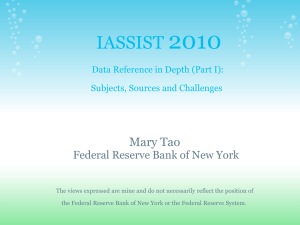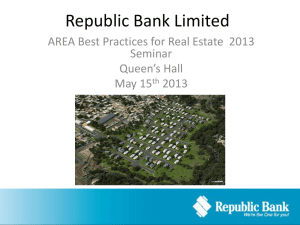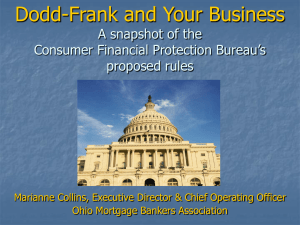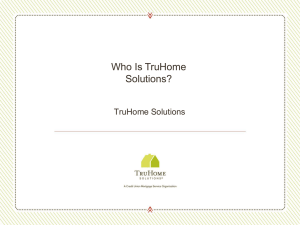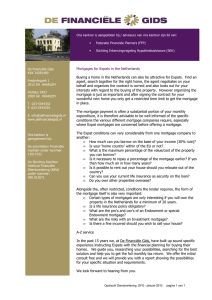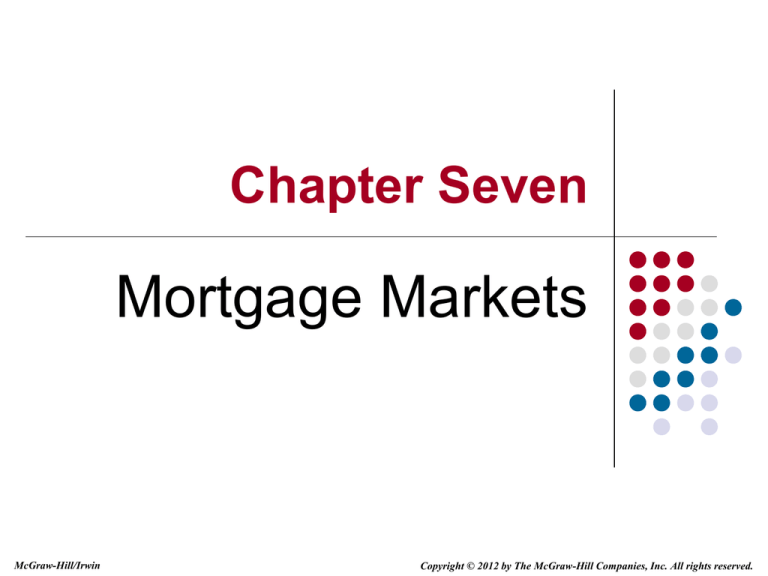
Chapter Seven
Mortgage Markets
McGraw-Hill/Irwin
Copyright © 2012 by The McGraw-Hill Companies, Inc. All rights reserved.
Mortgages and Mortgage-Backed
Securities
Mortgages are loans to individuals or businesses to
purchase homes, land, or other real property
Many mortgages are securitized
Many mortgages are pooled and sold and then the
mortgage payments are used to collateralize mortgagebacked securities (MBSs)
Mortgages differ from bonds and stocks
mortgages are backed by a specific piece of real property
primary mortgages have no set size or denomination
comparatively little information exists on mortgage
borrowers
7-2
Primary Mortgage Market
Four basic types of mortgages are issued by
financial institutions
home mortgages are used to purchase one- to four-family
dwellings (called “single-family mortgages”)
multifamily dwellings mortgages are used to purchase
apartment complexes, townhouses, and condominiums
commercial mortgages are used to finance the purchase of
real estate for business purposes
farm mortgages are used to finance the purchase of farms
7-3
Breakdown of Mortgage Loans
2010 Total = $13.8 Trillion
7-4
Mortgage Characteristics
Collateral: lenders place liens against properties that prevent
sale until loans are fully paid off
A down payment is a portion of the purchase price of the
property a financial institution requires the borrower to pay up
front
private mortgage insurance (PMI) is generally required when
the loan-to-value ratio is more than 80%
Federally insured mortgages
repayment is guaranteed by either the Federal Housing
Administration (FHA) or the Veterans Administration (VA)
7-5
Mortgage Characteristics
Conventional mortgages are mortgages that are not
federally insured
Amortized mortgages have fixed principal and interest
payments that fully pay off the mortgage by its maturity date
fully amortized mortgage maturities are usually either 15 or 30
years
Balloon payment mortgages require fixed monthly interest
payments for 3 to 5 years whereupon full payment of the
mortgage principal is due
7-6
Mortgage Characteristics
Fixed-rate mortgages lock in the borrower’s interest rate
required monthly payments are fixed over the life of the mortgage
lenders assume interest rate risk
7-7
Mortgage Characteristics
Adjustable-rate mortgages (ARMs) tie the borrower’s
interest rate to some market interest rate or interest rate index
required monthly payments can change over the life of the
mortgage, although they may initially be fixed for a set time
period. For example, 5/1 ARMs and 3/1 ARMs are popular.
rates or payment changes must be ‘capped.’
For example, the cap on a 5/1 ARM may be stated as
‘5/2/5’
borrowers assume interest rate risk with an ARM
ARMs can increase default risk
7-8
Mortgage Characteristics
Discount points are fees or payments made when a
mortgage loan is issued
each point costs the borrower 1 percent of the principal value
the lender reduces the interest rate used to determine the
payments on the mortgage in exchange for points paid
Other fees
application fee
title search
title insurance
appraisal fee
loan origination fee
closing agent and review fees
other fees (e.g., VA or FHA loan guarantees and PMI)
7-9
Mortgage Characteristics
Mortgage refinancing
when a borrower takes out a new mortgage and uses the
proceeds to pay off an existing mortgage
mortgages are most often refinanced when an existing
mortgage has a higher interest rate than current rates
borrowers must balance the savings of a lower monthly
payment with the costs (fees) of refinancing
an often-cited rule of thumb is that the new interest rate
should be 2 percentage points less than the refinanced
mortgage rate
7-10
Mortgage Amortization
Each fixed monthly payment consists partly of
repayment of the principal and partly of the interest
on the outstanding mortgage balance
An amortization schedule shows how the fixed
monthly payments are split between principal and
interest
7-11
Mortgage Payments
The present value of a mortgage can be written as:
1 1 (1 r )t
PV PMT
r
PV = principal amount borrowed
PMT = monthly mortgage payment
r = monthly interest rate on the mortgage
t = number of monthly payments over the life of the mortgage
Rearrange to find the payment:
PV
PMT
1 1 (1 r)t
r
7-12
Mortgage Payments
A borrower agrees to a $200,000, 30-year fixed-rate mortgage
with a 5.75% (or 0.4792% per month) quoted interest rate.
What is the payment amount and how much of each payment
goes to principle and interest?
PMT
200,000
1 1 (1.004792)360
0.004792
$1,167.15
7-13
Mortgage Amortization Schedule
(1)
7-14
Mortgage Amortization Schedule
(2)
7-15
Other Types of Mortgages
Jumbo mortgages
Jumbo mortgages are mortgages for loan amounts that exceed
the maximum ‘conforming’ limits allowed by the mortgage
agencies Fannie Mae and Freddie Mac ($410,000 in 2010, with
some exceptions)
Subprime mortgages
Subprime mortgages are mortgages where the borrowers do not
qualify for a ‘prime’ credit rating because of a low credit score
arising from prior credit problems such as delinquencies and
defaults. Or they may simply lack sufficient credit history or have
insufficient income.
7-16
Other Types of Mortgages
Alt-A mortgages
Alternative A-papers are mortgages that are riskier than
prime but not as risky as subprime
Interest rates on Alt-A loans are usually between prime and
subprime rates
7-17
Other Types of Mortgages
Option ARMs (‘Pick-n-Pay’ mortgages)
Give homebuyers an initial choice of payment
options
a)
b)
c)
Minimum payment: 1% interest rate for 12 months, then
variable rate, capitalization of unpaid interest, growing loan
balance
Interest Only payment: pay interest only at an adjustable
rate for first 5 to 10 years of loan, payments will increase
substantially when IO term expires.
15-year or 30-year fully amortizing payment
7-18
Other Types of Mortgages
Second mortgages and home equity loans
Second mortgages are subordinated claims to senior
mortgages
Reverse-annuity mortgages (RAMs)
Retirees or homeowners with a substantial amount of
equity in their home can sell the equity back to a bank over
time
Various payment options are available
Costs and servicing fees are high
7-19
Secondary Mortgage Markets
FIs remove mortgages from their balance sheets
through one of two mechanisms
by pooling recently originated mortgages together and
selling them in the secondary market
by securitizing mortgages (i.e., by issuing securities
backed by newly originated mortgages)
Advantages of securitization
FIs can reduce the liquidity risk, interest rate risk, and
credit risk of their loan portfolios
FIs generate income from origination and service fees
7-20
Mortgage Sales
FIs have sold mortgages among themselves for over 100
years
A large part of correspondent banking involves small banks
selling parts of large loans to larger banks
Large banks often sell parts of their loans (i.e.,
participations) to smaller banks
Mortgage sales occur when an FI originates a mortgage and
sells it to an outside buyer
a loan sale is made with recourse if the loan buyer can sell the
loan back to the originator, should it go bad
7-21
Mortgage Sales
Mortgage sellers: money center banks, smaller banks,
foreign banks, investment banks
Mortgage sales allow FIs to manage credit risk, achieve better
asset diversification, and improve their liquidity and interest
rate risk positions
FIs are encouraged to sell loans for economic and regulatory
reasons
sold mortgages can still generate fee income for the bank
sold mortgages reduce the cost of reserve and capital
requirements
Mortgage buyers: foreign and domestic banks, insurance
companies, pension funds, closed-end bank loan mutual
funds, and nonfinancial corporations
7-22
Secondary Mortgage Markets
The U.S. government established the Federal National
Mortgage Association (FNMA or Fannie Mae) in the 1930s
to buy FHA and VA mortgages from thrifts so they could make
more mortgage loans
The Federal Home Loan Mortgage Corporation (FHLMC or
Freddie Mac) was formed in 1968 to facilitate financing of
conventional mortgages
7-23
Secondary Mortgage Markets
Government National Mortgage Association (GNMA or
“Ginnie Mae”) and Federal Home Loan Mortgage Corp.
(FHLMC or “Freddie Mac”) created in the 1960s
encouraged continued expansion of the housing market,
particularly for lower-income housing
GNMA does not securitize mortgage, rather it provides direct and
indirect guarantees that allow private entities to create mortgagebacked securities
7-24
Secondary Mortgage Markets
Securitization and Congressional goals to increase funding for
housing to lower income individuals led to weakening credit
standards and increases in the number of high risk loans
(called subprime mortgages)
Beginning in 2006, problems in the subprime mortgage
market led to the financial crisis of 2007 and 2008
7-25
Secondary Mortgage Markets
Between May 2005 and February 2007 subprime mortgage
default rates increased from 5.37% to 10.09%
Subprime mortgage holders 60 days or more behind in their
payments hit 17.1% in June 2007 and was over 20% in
August of the same year
7-26
Secondary Mortgage Markets
Problems in the subprime market spilled over to the broader
mortgage markets and helped fuel nationwide declines in
home prices which put many homeowners underwater and led
to the bankruptcies of many major financial institutions
On September 7, 2008, the Federal Housing Finance Agency
(FHFA) placed both Fannie Mae and Freddie Mac in
government conservatorship
7-27
Mortgage-Backed Securities
Pass-through securities “pass through” promised
principal and interest payments to investors
Three agencies are directly involved in the creation
of pass-through securities
Ginnie Mae
Fannie Mae
Freddie Mac
Private mortgage pass-through issuers create
pass-throughs from nonconforming mortgages
7-28
Mortgage-Backed Securities
Collateralized mortgage obligations (CMOs) are multiclass
pass-throughs with multiple bond holder classes or tranches
each bond holder class has a different guaranteed coupon
mortgage prepayments retire only one tranche at a time, so
all other trances are sequentially prepayment protected
Mortgage-backed bonds (MBBs)
MBBs allow FIs to raise long-term low-cost funds without
removing mortgages from their balance sheets
a group of mortgage assets is pledged as collateral against
a MBB issue, but there is no direct link between the cash
flows of the mortgages and the cash flows on the MBB
7-29
Mortgages Outstanding by
Type of Holder (%)
2.26% 0.63%
2.72%
3.30%
Depository Institutions
33.16%
Govt Agency Holdings &
Held in Pools
Mortgage Companies
Life Insurers
Other FIs
57.93%
Other
7-30
Mortgage Backed Securities
Outstanding Trillions $
Total = $7.48 Trillion
7-31
International Trends in
Securitization
Europe is the world’s second largest and most developed
securitization market
the United Kingdom is the biggest MBS issuer in the European
market, followed by Germany
the advent of the Euro has accentuated the increased trend in
securitization in Europe
Parts of Europe and Asian real estate markets were not as
affected by the mortgage crisis because they lacked
substantial subprime lending
7-32
International Trends in
Securitization
Banks in Great Britain, Ireland, Iceland, Spain, the
Netherlands, Switzerland, and Germany did have substantial
mortgage related losses that resulted in bailouts and passage
of economic stimulus programs
Securitization has declined due to the crisis but will continue
in the future
7-33

